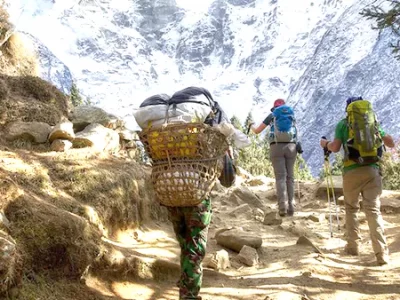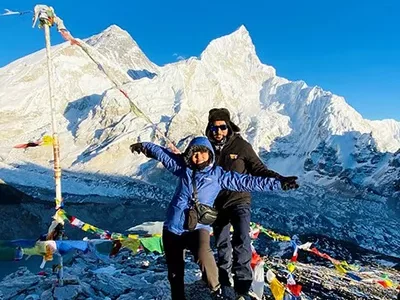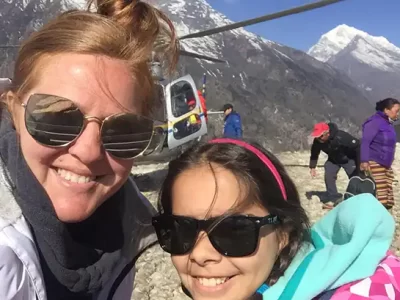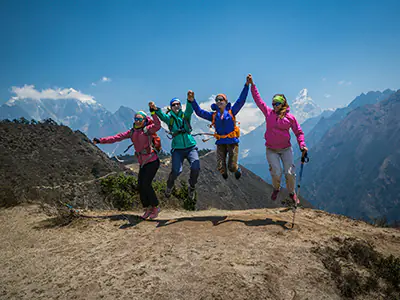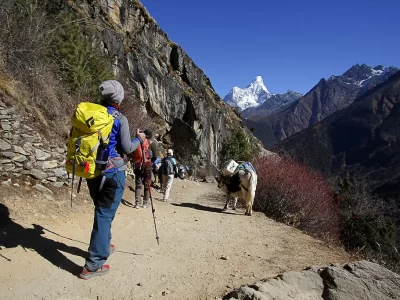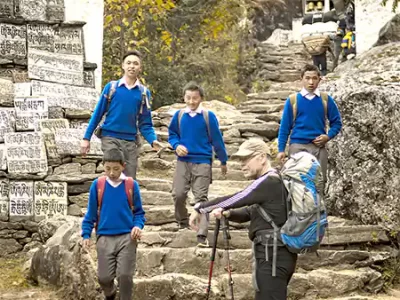The Everest View Trek invites adventurers to immerse themselves in the Himalayan majesty without the full-scale challenge of the Everest Base Camp trek. Perfect for those eager to soak in the majestic vistas of Mount Everest and its neighboring peaks, this trek offers a shorter, less demanding route.
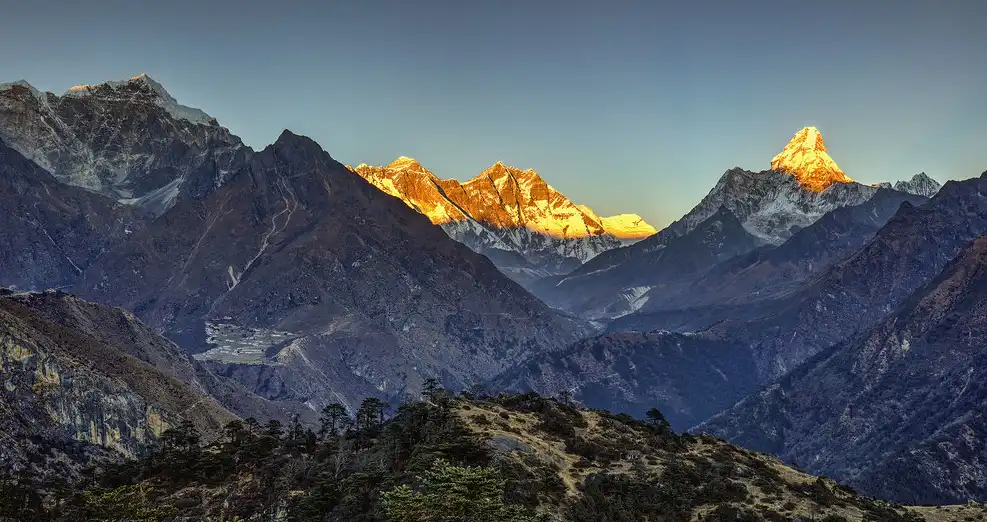
As you traverse the path, you’ll be treated to expansive views of the world’s highest mountain, crafting an experience you will remember. While it may seem less challenging, take into account the difficulty of Everest View Trek. High-altitude walking presents its own set of challenges, yet with the right preparation and acclimatization, it’s accessible even to beginners and those with average fitness.
Highlights
- Stunning Mount Everest Views: Enjoy sweeping views of Mount Everest and its neighboring peaks.
- Tengboche Monastery: Experience the spirituality and history of this breathtaking monastery set against mountain backdrops.
- Namche Bazaar: Dive into the bustling Sherpa town, known for its cultural richness and as a vital trading center.
- Everest Base Camp View: Capture the essence of the Everest Base Camp from a unique lookout point without completing the entire trek.
- Sherpa Culture: Engage with the deep-rooted traditions and warm hospitality of the local Sherpa community.
The clearly marked trail is easy to follow with the help of an Everest view trek map that points out significant landmarks and places to rest, ensuring a safe and pleasant trip. A major highlight is the Everest base camp view, offering a glimpse of the base camp from a unique perspective without the need to hike all the way there.
The Mount Everest view trek from different points along the route is truly spectacular. This trek provides numerous opportunities for trekkers to take stunning photos and build memories that last. Blending natural beauty with cultural encounters and manageable physical activity, the Everest View Trek appeals to a diverse array of travelers.
Everest View Trek
Everest Base Camp Trek
Everest Base Camp Trek with Helicopter Return
Mount Everest View Trek Itinerary
Day 1: Arrival in Kathmandu (1,400m)
Upon landing at Tribhuvan International Airport, a representative will welcome you and escort you to your hotel in Thamel. Attend a briefing session about the Everest View Trek and meet your guide.
Day 2: Kathmandu to Lukla (2,840m), then Trek to Phakding (2,610m) – 3 hours
Begin your adventure with a 40-minute flight to Lukla, showcasing panoramic views of the Himalayas.
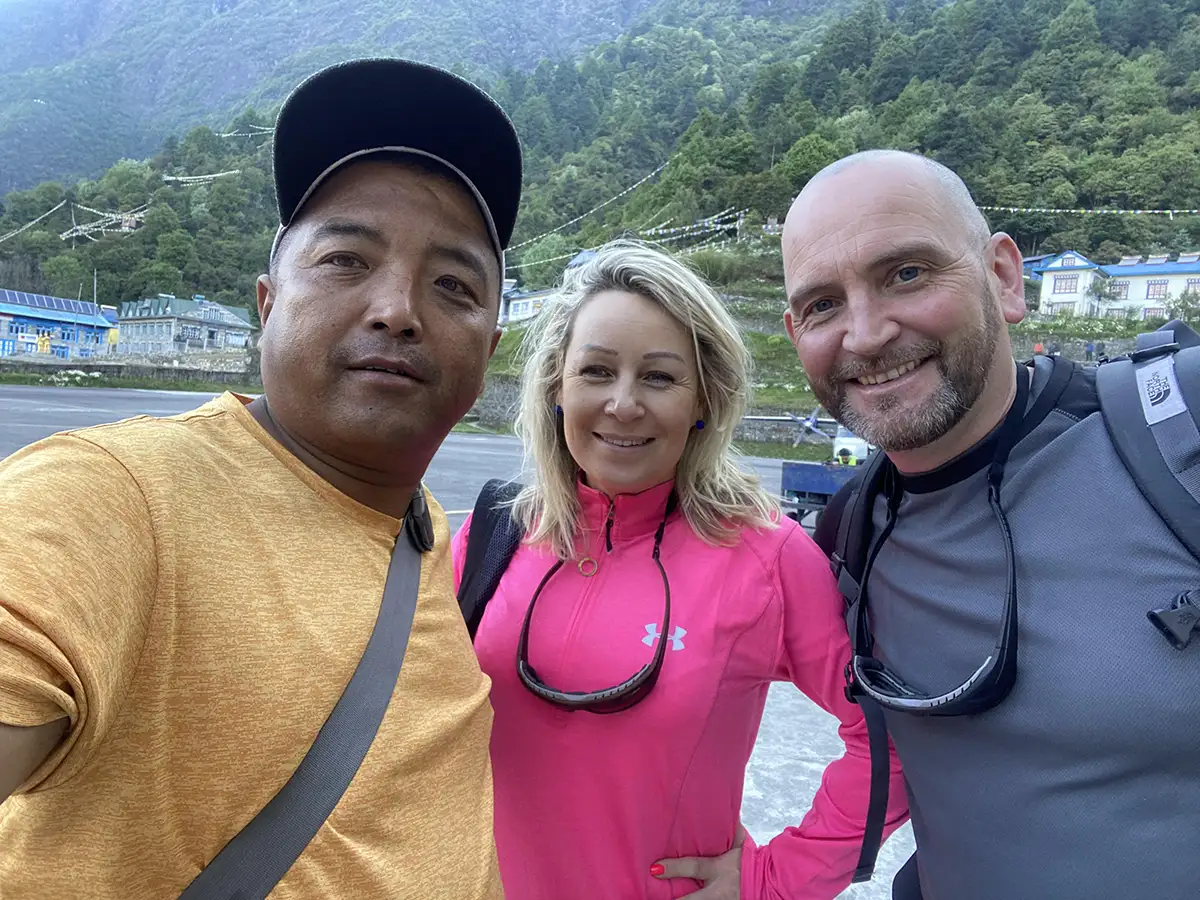
After landing at Hillary Airport, start trekking through Lukla village, passing rhododendron forests and Sherpa villages. Reach Phakding after about three hours of walking and stay overnight.
Day 3: Phakding to Namche Bazaar (3,440m) – 5-6 hours
Trek along the Dudh Koshi River, passing through Monjo and entering Sagarmatha National Park.
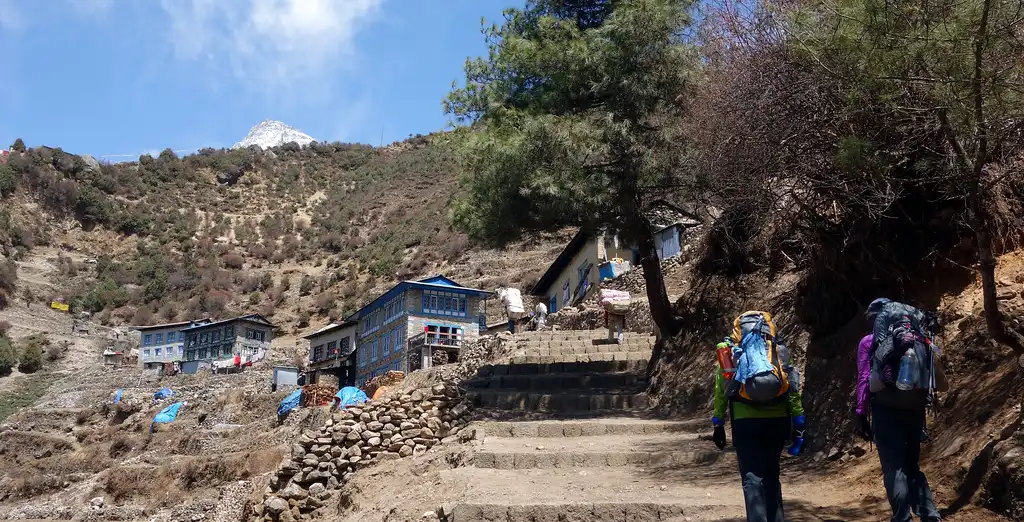
After a steep climb and crossing the Hillary Suspension Bridge, arrive at Namche Bazaar, the vibrant hub of the Khumbu region. This day’s trek takes approximately 5-6 hours.
Day 4: Acclimatization Day in Namche Bazaar (3,440m)
Acclimate to Namche Bazaar and visit the Everest View Hotel for panoramic views of Everest, Ama Dablam, and other peaks. Explore the Sherpa culture in Khumjung village before returning to Namche for the night.
Day 5: Namche Bazaar to Tengboche (3,860m) – 5 hours
Resume trekking with stunning mountain views. After a gentle walk and a steep climb, reach Tengboche, home to the famous Tengboche Monastery.
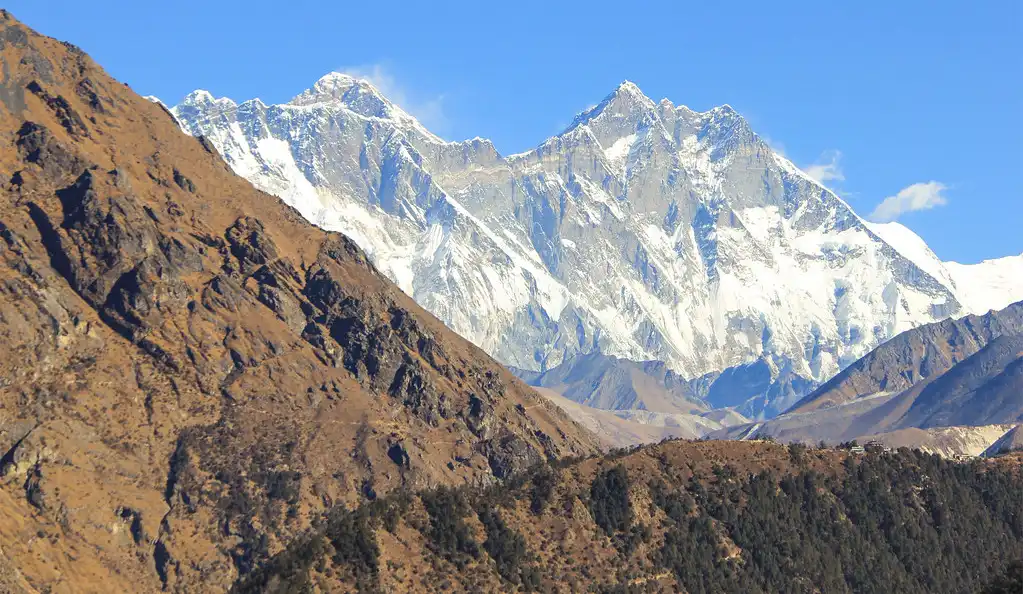
Enjoy close-up views of Ama Dablam and Everest. This day’s trek takes about 5 hours.
Day 6: Tengboche to Namche Bazaar (3,440m), then Monjo (2,835m) – 7-8 hours
Enjoy the morning views before trekking back to Namche Bazaar and continuing to Monjo. This descent takes approximately 7-8 hours, allowing for more photographs of the scenic beauty along the familiar trails.
Day 7: Monjo to Lukla (2,840m) – 5 hours
On your last trekking day, follow the Dudh Koshi River back to Lukla, passing through green hills and Sherpa villages. This 5-hour trek offers time to reflect on your trip and enjoy a farewell dinner with your trekking team.
Day 8: Flight to Kathmandu (1,400m)
Fly back to Kathmandu in the morning. Depending on the flight schedule, you may have time to go sightseeing in the Kathmandu Valley and visit landmarks such as Pashupatinath, Boudhanath, and Swayambhunath. Stay overnight in a hotel.
Day 9: Full-Day Kathmandu Sightseeing (1,400m)
Explore Kathmandu’s UNESCO World Heritage Sites, including Kathmandu Durbar Square and Patan Durbar Square.
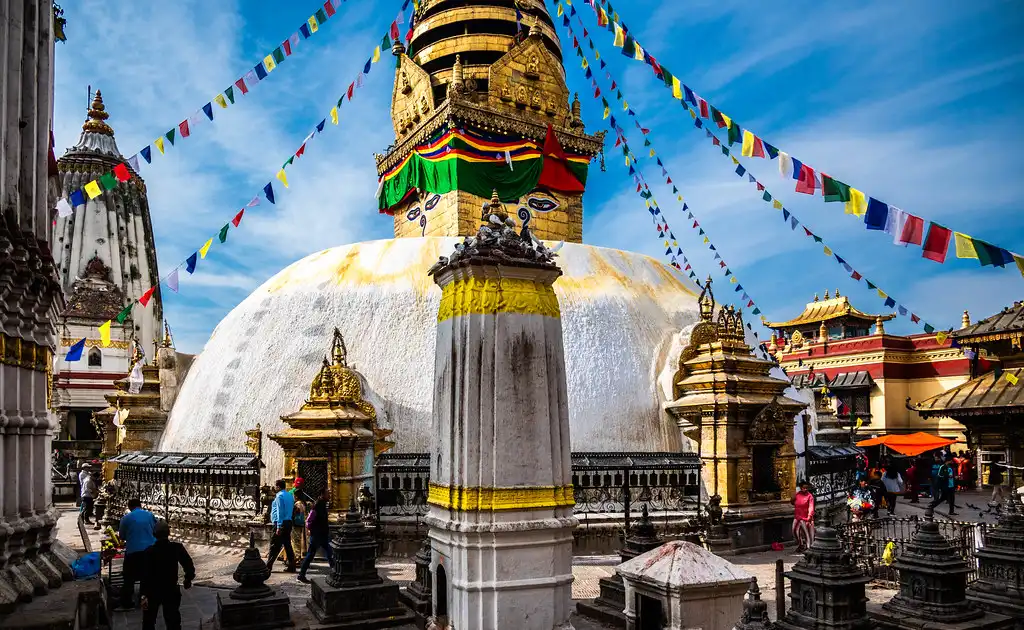
This day also serves as a buffer for any potential flight delays.
Day 10: Departure from Kathmandu (1,400m)
Your Everest View Trek will come to a conclusion when you transfer to Tribhuvan International Airport for your trip home.
Everest Base Camp Trek for Beginners
Everest Base Camp Short Trek
Everest Panorama Trek
Everest View Trek Distance
The Everest View Trek takes trekkers through the iconic landscapes of the Everest region, renowned for its majestic Himalayan peaks. This trek typically spans approximately 30 to 50 kilometers (18 to 31 miles) round trip, depending on the chosen itinerary.
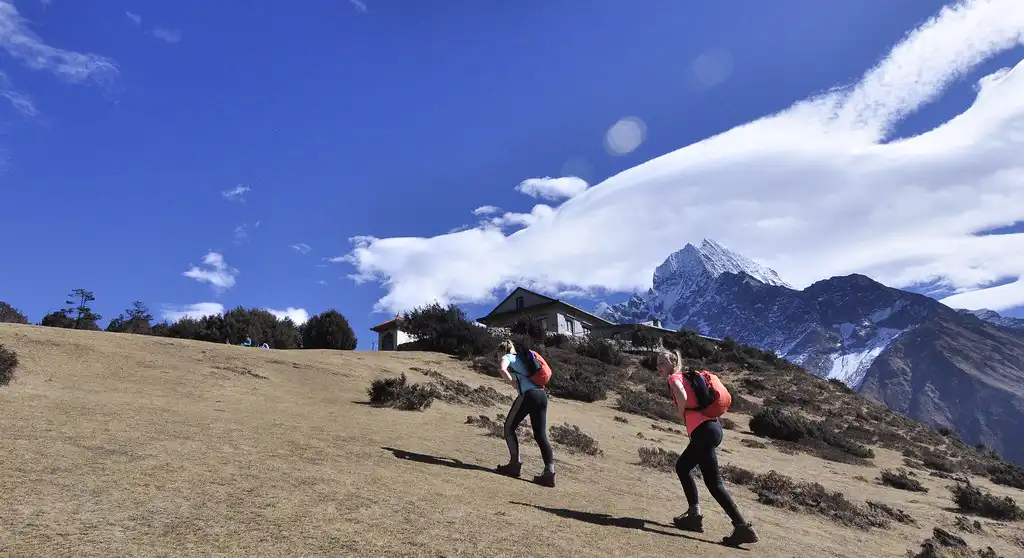
The trip commences with an exhilarating flight from Kathmandu to Lukla, where trekkers begin their adventure by trekking through lush forests and crossing suspension bridges over the Dudh Koshi River. This initial leg introduces travelers to Sherpa culture and the natural splendor of the region.
As trekkers ascend into the Himalayas, they pass through quaint Sherpa villages like Phakding and Monjo, each offering unique insights into local life. Namche Bazaar stands out as a bustling trading hub nestled amidst the mountains, where trekkers acclimatize while enjoying panoramic views and exploring vibrant markets.
Continuing onwards, trekkers will reach Tengboche, renowned for its ancient monastery and offering breathtaking vistas of Ama Dablam and Everest. The Everest View Trek culminates with a visit to the Everest View Hotel in Syangboche, renowned for its unparalleled panoramic views of Mount Everest and its neighboring peaks.
This vantage point provides a breathtaking reward for trekkers before they begin their descent back to Lukla, completing the circular trek. Throughout the trek, trekkers encounter a variety of terrains, from gentle slopes to occasional rocky paths, ensuring a memorable and fulfilling trekking experience in the heart of the Himalayas.
Everest View Trek Difficulty
The Everest View Trek difficulty stands at a moderate level. It caters to individuals with basic fitness levels and only demands a little high-altitude trekking experience. Participants will trek for several hours daily across diverse terrains.
The trek doesn’t approach the extreme heights seen in the Everest Base Camp Trek, significantly lowering the risk of severe altitude sickness and rendering it more accessible to a broader range of trekkers.
Suitability Analysis
For Beginners: Perfect for newcomers to trekking, this trek lets you experience the Himalayas without the harsh physical strain typical of higher, more prolonged treks. Trekkers easily tackle the well-maintained paths, which feature manageable challenges like uphill sections with regular breaks.
For Those with Moderate Fitness: Even individuals with an average level of fitness will find this trek within their capabilities. Regular activities like brisk walking or cycling before the trek enhance stamina and enrich the overall trekking experience.
Preparation Tips
Physical Training: Kick off with gentle cardiovascular exercises such as walking or jogging, and progressively ramp up the intensity and duration. Add strength training to your routine, focusing on your legs, back, and core to prepare for the daily physical demands of hiking with a backpack.
Hiking Practice: Undertake weekend hikes that replicate the trek’s conditions, particularly in terms of elevation gains and trail types. You can test out your trekking gear, especially your hiking boots and backpack, to make sure they are comfortable and suit your needs.
Altitude Acclimatization: If feasible, spend time in high-altitude areas prior to your trek to get your body accustomed to lower oxygen levels. Please be aware of the signs of altitude sickness and the importance of staying hydrated and maintaining a proper pace.
Training Guidelines
Cardiovascular Fitness: Make sure to do at least three different physical activities per week, such as swimming, cycling, or running, and concentrate on increasing the duration and intensity of each session to develop endurance.
Strength Training: Concentrate on building lower body strength with squats and lunges and upper body strength with pull-ups and push-ups to navigate uneven terrains and manage your backpack.
Flexibility and Balance: Incorporate yoga or pilates into your regimen to enhance flexibility and balance, aiding in navigating challenging paths and reducing injury risks.
Mental Preparation: Familiarize yourself with the trek’s route and daily itinerary to set realistic expectations. Practice mindfulness or meditation to build mental resilience, which is essential for tackling the physical and mental challenges of the trek.
Best Time to Trek
Spring (March to May)
Spring stands out as one of the most favored seasons for the Everest View Trek. During these months, trekkers enjoy moderate temperatures and clear skies, which offer magnificent views of Mount Everest and the surrounding peaks. Trekking conditions are comfortable because daytime temperatures normally vary from 10°C to 20°C.
Benefits of Trekking in Spring
- Blooming Flora: The trails burst into color with blooming rhododendrons and other flowers, making the landscape particularly picturesque.
- Ideal Temperatures: Trekkers manage moderate daytime temperatures well for trekking while they handle cooler nights with appropriate gear.
- Clear Views: Spring usually provides clear skies, ensuring unobstructed and spectacular views of the mountains, which are ideal for photography and soaking in the natural beauty.
- Mountaineering Season: Spring attracts many mountaineers attempting to summit Everest, adding an exciting element to the trek as trekkers encounter climbing expeditions along the way.
Autumn (September to November)
Autumn is another prime season for the Everest View Trek. This period features stable weather conditions and clear skies following the monsoon rains, offering some of the year’s best mountain views. The average daily temperature is between 15°C and 20°C, with lower evening temperatures.
Benefits of Trekking in Autumn
- Post-Monsoon Clarity: The air is clean and crisp after the monsoon, providing excellent visibility for stunning mountain views and photography.
- Festive Atmosphere: Autumn coincides with major Nepalese festivals like Dashain and Tihar, allowing trekkers to experience and participate in rich cultural celebrations.
- Stable Weather: The weather is generally predictable and stable, minimizing the risk of weather-related disruptions and enhancing the trekking experience.
- Lush Landscapes: The trails are surrounded by lush greenery, making the trek more enjoyable and visually appealing.
Winter (December to February)
Winter offers a unique trekking experience, presenting both challenges and rewards. The temperatures are significantly colder, especially at higher altitudes, but the trails are less crowded, providing a serene and peaceful trekking environment. Daytime temperatures range from -5°C to 10°C, with nights being much colder.
Benefits of Trekking in Winter
- Quieter Trails: Fewer trekkers venture out during winter, ensuring a more peaceful and solitary trekking experience.
- Stunning Scenery: The snow-covered landscapes and clear, crisp skies offer breathtaking views of the mountains.
- Challenging Adventure: Winter trekking adds an extra layer of challenge and adventure, making it appealing for those who enjoy trekking in snowy and cold conditions.
Monsoon (June to August)
The monsoon season brings heavy rainfall, high humidity, and warmer temperatures. While this is not the most popular time for trekking, it provides a unique experience for those who appreciate lush, green landscapes and are okay with trekking in the rain.
Benefits of Trekking in Monsoon
- Lush Greenery: The landscape is at its most vibrant and green during the monsoon, with an abundance of flora and fauna.
- Less Crowded: The trails are significantly less crowded, offering a more personal and intimate trekking experience.
- Unique Experience: Trekking in the rain can be a unique and adventurous experience, perfect for those who enjoy the monsoon atmosphere and lush environment.
- Cultural Immersion: There are more opportunities to engage with people and really immerse oneself in the rich local culture when there are fewer trekkers around.
Accommodation and Meals
Trekkers on the Everest View Trek typically stay in tea houses, which are basic lodges offering essential amenities. These accommodations provide a simple room with a bed, blankets, and occasionally a shared bathroom. As you ascend, the facilities become more rustic, but they offer a cozy place to rest. In popular areas like Namche Bazaar, lodges may have more amenities, including hot showers and Wi-Fi, although these come at an extra cost.
Meals on the trek are hearty and designed to keep you energized. Typical meals include dishes like dal bhat (lentil soup with rice), noodles, soups, and potatoes. Breakfast usually features porridge, eggs, and Tibetan bread. Staying hydrated is crucial, so drink plenty of water and eat high-energy snacks like nuts and dried fruits to maintain energy levels. To stay healthy and avoid altitude sickness, avoid alcohol and stick to cooked foods.
Everest View Trek Map
The Everest View Trek map charts a scenic trail that lets trekkers enjoy stunning views of Mount Everest and nearby peaks without the intensity of a full Everest Base Camp trek. Flights from Kathmandu to Lukla, a town known for its striking mountain airport, mark the beginning of the journey.
From Lukla, the trail leads to Phakding, passing through charming villages and lush forests. You will arrive at Namche Bazaar, the bustling center of the Khumbu district and a vital acclimatization station, as you continue your trip.
Here, trekkers can explore local markets, take in panoramic mountain views, and visit the Everest View Hotel, which offers one of the best vantage points for seeing Mount Everest, Ama Dablam, and other towering peaks. The route then takes trekkers to Tengboche, where they encounter the renowned Tengboche Monastery, surrounded by breathtaking mountain scenery.
Key Landmarks
- Lukla: The trek begins here, which is known for its thrilling airport landing.
- Phakding: The first overnight stop, providing a gentle introduction to the trek.
- Namche Bazaar: A key acclimatization spot with markets, cafes, and the famous Everest View Hotel.
- Tengboche Monastery: A cultural and spiritual site offering stunning views of the mountains.
Everest View Trek Cost
The cost of the Everest View Trek generally falls between $1250 and $1450 per person for a standard 10-day package. This price typically includes accommodations in a three-star hotel in Kathmandu, standard lodges during the trek, and three daily meals while trekking.
This price also includes the cost of required permissions, such as the Trekkers’ Information Management System (TIMS) card and the Sagarmatha National Park admission fee. Additionally, the package often includes round-trip flights from Kathmandu to Lukla, airport transfers, and the services of an experienced guide and porters.
However, trekkers should budget for additional expenses not included in this package. These costs can include international airfare, Nepal visa fees, travel insurance, and personal trekking gear. Trekkers also need to cover other personal expenses such as snacks, drinks, laundry, and tips for guides and porters.
Optional expenses involve additional porter services, upgraded accommodations, and extra activities or sightseeing tours in Kathmandu. It’s crucial to confirm the detailed inclusions and exclusions with the trekking company to avoid any unexpected costs.
Permits for the Everest View Trek
1. Sagarmatha National Park Entry Permit
To enter Sagarmatha National Park, which includes Mount Everest and its surroundings, trekkers must first have an admission permit. This permit is crucial for conserving the natural environment and biodiversity of the region. As of recent updates, the permit fee amounts to approximately NPR 3,000 (about USD 30) per person.
2. Trekkers’ Information Management System (TIMS) Card
The Nepal Tourism Board mandates the TIMS card for all trekkers in Nepal, including those undertaking the Everest View Trek. The fee for TIMS cards varies depending on whether trekkers are traveling independently or with a registered trekking agency.
Essential Gear and Packing List
Clothing
- Ensure you have moisture-wicking base layers for managing sweat and maintaining body temperature.
- Pack fleece or down jackets to stay warm at higher altitudes.
- Opt for lightweight, quick-drying trekking pants with zip-off options for versatility.
- Wear sturdy, broken-in hiking boots with ankle support and good traction.
- Pack several pairs of moisture-wicking socks to prevent blisters.
Accessories
- Carry a warm beanie or hat for cold mornings and gloves for higher altitudes.
- Don UV-protective sunglasses with side shields to shield from intense mountain glare.
- Bring a versatile buff or scarf for warmth, dust protection, and as a face covering.
Gear
- Opt for a comfortable daypack with good support to carry essentials during the day.
- Utilize adjustable trekking poles for stability and to lessen strain on knees during descents.
- Ensure you have a headlamp or flashlight for navigating in the dark or lodges with limited lighting.
- Stay hydrated using reusable water bottles or a hydration pack.
Personal Care
- Pack travel-sized toiletries, including sunscreen, lip balm, wet wipes, and hand sanitizer.
- Keep a basic first-aid pack on you that includes adhesive bandages, blister cures, analgesics, and any prescription drugs you may need.
- Bring a quick-dry towel for personal hygiene in lodges.
Miscellaneous
- Capture stunning mountain vistas with a lightweight camera or smartphone.
- Keep devices charged with a power bank for essential communication or navigation.
- Carry a trekking map and guidebook for navigation and learning about landmarks along the route.
Tips on Packing Efficiently
- Layer clothing for versatility and adjustability based on temperature changes.
- Adopt a minimalist approach to avoid overpacking and respect weight limits for porters.
- To keep your equipment organized and to reduce room within your bag, use compression sacks.
- Prioritize moisture-wicking fabrics that dry quickly and are comfortable for repeated wear.
Health and Safety Tips
Acclimatization plays a crucial role in the Everest View Trek to prevent altitude sickness. It’s important to ascend gradually, allowing your body ample time to adjust to higher altitudes. I would suggest you spend an extra day in Namche Bazaar for acclimatization purposes. Since alcohol can hasten dehydration at altitude, stay hydrated by drinking lots of water.
Recognize symptoms of altitude sickness, such as headaches, nausea, and dizziness, and descend to lower altitudes if symptoms worsen. Regarding overall health and security, make sure you include a properly stocked first aid bag with prescription drugs for common ailments like headaches and stomachaches. Use wet wipes and hand sanitizer to maintain proper hygiene, particularly in isolated locations with maybe limited amenities.
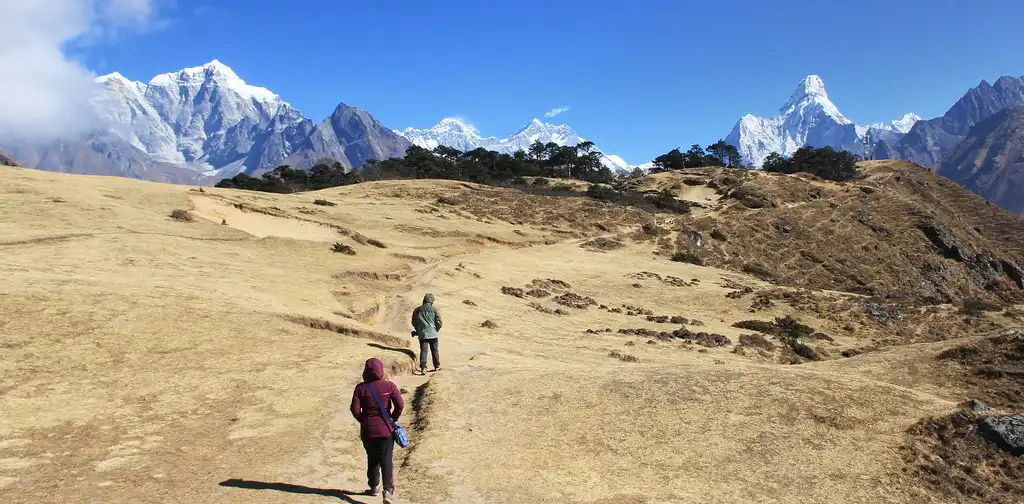
Use sunscreen and sunglasses to protect your eyes from UV rays when you’re outside. Regarding trail safety precautions, always heed the counsel and direction of your hiking guide and local authorities. It is very important to have emergency contact information at hand.
Please always keep a list of important phone numbers with you, such as the number of your Nepali embassy or consulate, the contact information for emergency services in your area, and the details of your trekking agency. Keep yourself informed about trail conditions and weather forecasts, and get familiar with evacuation protocols in case of emergency. To ensure your safety and well-being during the hike, please be ready to change your plans as needed.
Conclusion
This guide has explored the beauty and adventure of the Everest View Trek, renowned for its breathtaking views of the Himalayas. Essential aspects such as the trek route, necessary permits like the Sagarmatha National Park Entry Permit and TIMS card, as well as detailed gear recommendations and health tips for a safe trekking experience, were discussed.
Emphasizing acclimatization strategies and general safety precautions ensures trekkers enjoy the trek while staying healthy and well-prepared. Exploring the Everest View Trek promises not only scenic vistas of Mount Everest and surrounding peaks but also a cultural immersion into the Sherpa community and their way of life. Whether you’re experienced or new to trekking, this trip offers an unforgettable experience amidst the world’s highest mountains.

